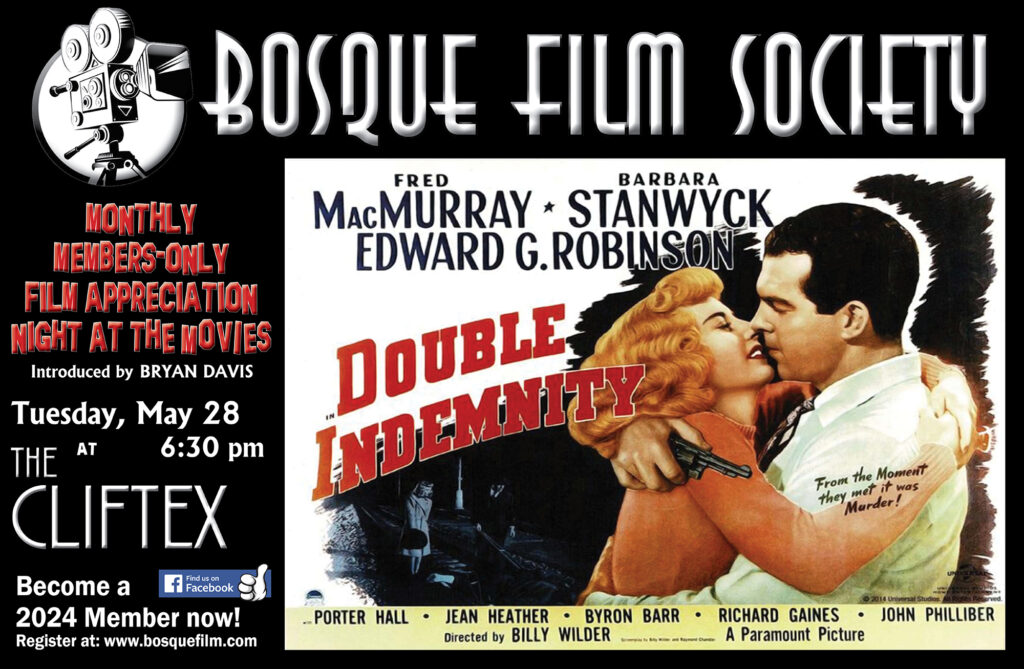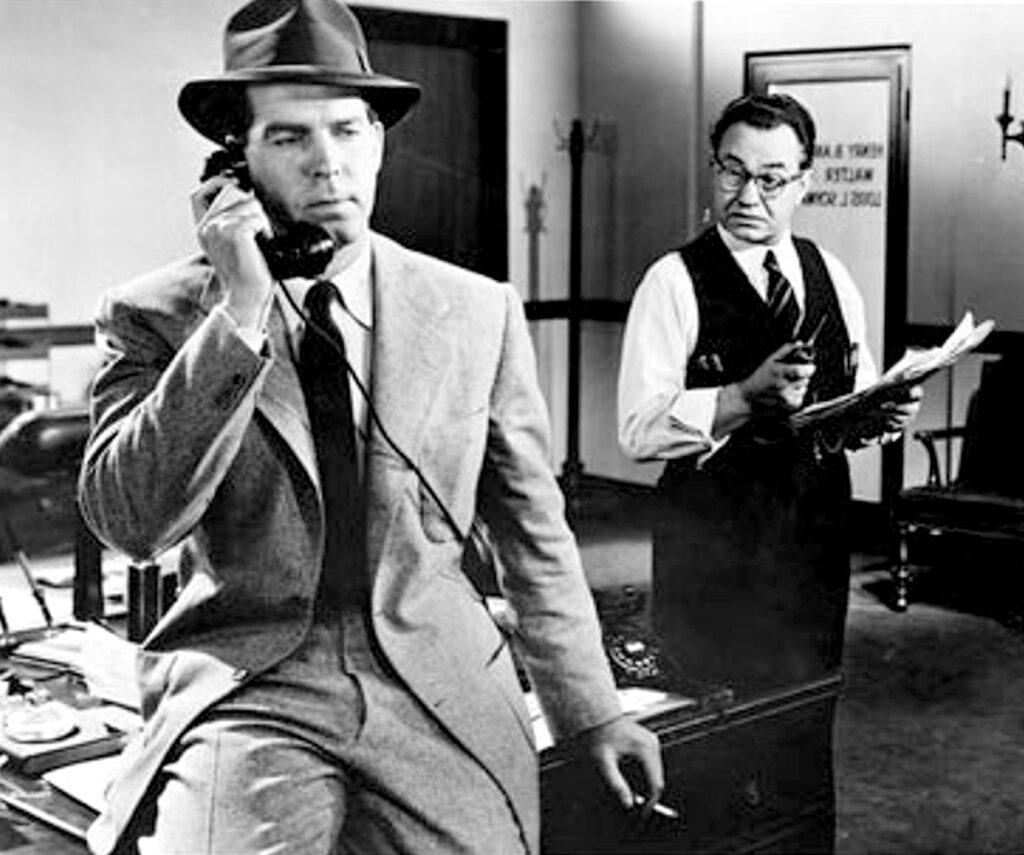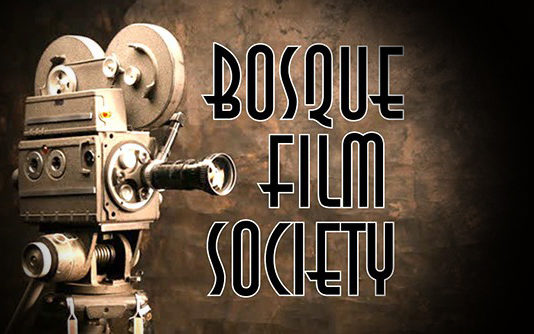With screening of the classic 1944 crime thriller film noir “DOUBLE INDEMNITY,” the magic of director Billy Wilder on full display at the historic Cliftex Theatre in Clifton
By BRYAN DAVIS
Bosque Film Society Historian & Founding Board Member
“I picked you for the job, not because I think you’re so darn smart, but because I thought you were a shade less dumb than the rest of the outfit.”
Could I introduce a classic film I didn’t like? I suppose so, but it wouldn’t be nearly as much fun. I love “Double Indemnity.” It’s certainly one of my favorite movies. It’s the first film that brought universal acclaim to Billy Wilder, my all-time favorite director from the Golden Age of Hollywood. I liked it when I first saw the film as a kid on TV in the 1960s.
 And I’m not alone in my admiration for this movie. The American Film Institute, which updates its 100 Best Films List every 10 years, currently has it ranked at #29. That puts it above “The Sound of Music,” “West Side Story,” “Taxi Driver,” and about 25 other best picture Academy Award winners, even though it didn’t win a single Oscar.
And I’m not alone in my admiration for this movie. The American Film Institute, which updates its 100 Best Films List every 10 years, currently has it ranked at #29. That puts it above “The Sound of Music,” “West Side Story,” “Taxi Driver,” and about 25 other best picture Academy Award winners, even though it didn’t win a single Oscar.
“Double Indemnity” also tops just about every list in the film noir genre. Rotten Tomatoes calls it “the gold standard of Hollywood film noir.” Another poll of film critics calls it “the poster child of film noir.” You’ve heard us talk of film noir here many times with the Bosque Film Society. But I’ll share an online definition.
“The phrase film noir was first coined in 1946 (two years after this movie was made) by a group of French critics to describe the emerging movement of mainly black and white Hollywood films with dark, pessimistic themes and signature motifs such as alienated antiheroes, rain slick streets, dark shadows and seductive femme fatales.” That sounds pretty much like the plot for “Double Indemnity.”
In the essence of time, I won’t delve into plot details, I’ll stick to what I enjoy most about classic film reviews…and that’s the personalities that made the movies we love great. In the case of “Double Indemnity,” I’ll limit that to the director, screenwriters and the film’s three stars. But first, I want to tell you that the movie did play here at the Cliftex Theatre 80 years ago in October 1944. Movies then played seven days a week at twice daily at 2:15 and 7:15 p.m. Thank you to our board secretary Nathan Diebenow for supplying that information.
 The Director and Screenwriter: Billy Wilder
The Director and Screenwriter: Billy Wilder
A few years ago, I introduced another of my all-time favorite films, Billy Wilder’s “Sunset Boulevard.” I devoted most of my remarks to my admiration of Wilder’s work. He’s is one of my three favorite directors, and I believe exhibits the most versatility of them all. “Double Indemnity” really put him on the map in 1944, and it led him to an amazing 20-year reign as one Hollywood’s premier directors. In fact, his film work spans parts of EIGHT decades, from 1929 to 1981.
Wilder left his native Austria to begin his film career in Germany, before fleeing to Paris when the Nazis came to power. He would eventually leave France for Hollywood, but lost most of his immediate Jewish family in the concentration camps. In Hollywood, Wilder’s success would garner him an amazing 21 Oscar nominations (12 for his screenplays, and seven for directing) winning seven total Oscars. His first nominations came for the screenplay and direction of tonight’s feature, “Double Indemnity.”
The film was based upon the 1943 pulp fiction novel by American crime writer James M. Cain, who also penned “Mildred Pierce” and “The Postman Always Rings Twice.” The novel was adapted for the screen by Billy Wilder and writing partner Raymond Chandler.
In my estimation, any great film begins with writing, then the direction. Lucky for the viewer, Billy Wilder was the master of both. But Wilder needed help with dialog, and he always sought out the best. The most frequent writing partner was Charles Brackett, but Brackett said “Double Indemnity” was too dark for him to tackle.
So, Wilder turned to Raymond Chandler, another masterful writer. The only problem… Chandler was barely a functioning alcoholic, and the all-night sessions of writing together while drinking was a horrible experience. Wilder hated Chandler so much he didn’t invite him to Academy Awards for the screenplay of the film they were nominated for. And how about this quote from Wilder’s autobiography 50 years after the movie was made, about just how much he despised his writing partner.
 “Sure the anger gets washed and watery with time. And that’s a good thing. I cannot forgive Hitler, but I certainly can forgive Chandler. But there was a lot Hitler in Raymond Chandler.”
“Sure the anger gets washed and watery with time. And that’s a good thing. I cannot forgive Hitler, but I certainly can forgive Chandler. But there was a lot Hitler in Raymond Chandler.”
Let me tell you about a writer’s revenge. The experience with Chandler led Wilder to write his next film, “The Lost Weekend,” with Chandler being his inspiration for the drunken writer played by Ray Milland in an Oscar-winning performance. Many film historians consider this film the best movie ever made ever made about effects of alcoholism and addiction. It would win Wilder his first of seven Oscars the following year for best screenplay and directing.
The dialog in this film is rich. Then men carefully danced around the Hays Code, the film censors of the day, to deliver some of the best innuendo on the screen up to that time. The envelope was pushed so far by Wilder that the film was quite controversial.
Today, 80 years after its release, the “Double Indemnity” screenplay is ranked the 26th Best Movie Screenplay by the Writers Guild of America. But careful, don’t try and count how many times Fred MacMurray calls Barbara Stanwyck “baby” or you’ll not be able to follow the plot.
So, “Double Indemnity” put Billy Wilder on the map, but he went on to direct “Sunset Boulevard,” generally regarded as the best film ever made about the Hollywood. The American Film Institute calls Wilder’s 1959 Marilyn Monroe classic, “Some Like It Hot,” the best comedy ever made. Then his dramatic turns include two Oscar-winning best pictures, “The Lost Weekend” in 1945 and “The Apartment” in 1960.
In between, Wilder gave us such classics as “Stalag 17” “Witness for the Prosecution,” and the romantic classic, “Sabrina.” Few ever matched his range in film. When Alfred Hitchcock first saw “Double Indemnity,” he famously remarked, “Since Double Indemnity, the two most important words in motion pictures are ‘Billy’ and ‘Wilder.’”
In the American Film Institute’s List of 100 Greatest Films, Steven Spielberg leads all directors with five movies. With four each are Alfred Hitchcock and Billy Wilder. Wilder’s films on the list are “Double Indemnity,” “Some Like It Hot,” “Sunset Boulevard” and “The Apartment.”
 The Cast
The Cast
Today, Barbara Stanwyck is best remembered as the only female lead of the two-decade TV western genre, for her Emmy-winning role as Victoria Barkley in “The Big Valley.” But she also had one of the longest, most distinguished careers in Hollywood, spanning seven decades from the silent films in the 1920s until her death.
Stanwyck was born in the Bronx and orphaned by the age of four. She grew up in the New York foster care system and worked to help support her siblings as a dancer in speakeasies and as a member of the Ziegfeld Follies by the age of 15. She was a Broadway star before heading to Hollywood and had her first role in a 1927 silent film. Her first marriage to older vaudeville star Frank Fay was said to have inspired the film, “A Star Is Born,” but Stanwyck turned down a chance to play the lead in the first of four film versions of the story in 1936.
Stanwyck was equally at ease in screwball comedies, drama and the one medium Katherine Hepburn, Bette Davis or Joan Crawford wouldn’t dare touch…the western. In fact, she loved the western films so much that when she died, she instructed that her ashes be scattered from a helicopter over Lone Pine, California, where she had filmed some of her favorite Western films. Stanwyck was more at ease with stuntmen than attending Hollywood parties and movie premiers, insisting on perfecting her horse-riding skills and doing her own stunts.
Several of her directors called her their favorite actress to have worked with, including Frank Capra, Cecil B. DeMIlle and Billy Wilder. Stanwyck won four Oscar nominations, but never won a competitive Oscar. But television was kinder, where she won four Emmy Awards, including her last at age 76 playing Mary Carson in “The Thorn Birds.”
The year “Double Indemnity was made,” the IRS listed Barbara Stanwyck was the highest paid woman in the United States. But one role she hadn’t played before was a cold-blooded killer. When Wilder offered her the role of Phyllis Dietrichson, she said she was afraid it would ruin her career.
“What are you,” Wilder asked, “an actor or a mouse?” The challenge accepted, Stanwyck donned her famously bad blonde wig, a seductive ankle bracelet, and blazed her way into film history. The role also gave Stanwyck screen immortality.
 The American Film Institute has called her character in tonight’s film the eighth best screen villain in movie history. Only one actress scored higher on the list, Margaret Hamilton’s Wicked Witch in “The Wizard of Oz.” As for the bad wig, Wilder thought it would give Stanwyck the “cheap floozy” look he wanted Phyllis to have, despite Stanwyck’s objections.
The American Film Institute has called her character in tonight’s film the eighth best screen villain in movie history. Only one actress scored higher on the list, Margaret Hamilton’s Wicked Witch in “The Wizard of Oz.” As for the bad wig, Wilder thought it would give Stanwyck the “cheap floozy” look he wanted Phyllis to have, despite Stanwyck’s objections.
Stanwyck’s co-star was an unlikely choice, but Fred MacMurray was brilliantly cast against type as the cocky, gullible insurance salesman seduced for murder. MacMurray and Stanwyck had such onscreen chemistry, they were paired together in four more movies. But prior to “Double Indemnity,” MacMurray had been typecast as the good-looking best friend or romantic lead in lightweight comedies.
MacMurray’s role as Walter Neff was turned down by every big name in Hollywood, including James Cagney, Spencer Tracy, Gregory Peck, and Frederic March. Eventually, Wilder offered MacMurray the role he would forever be remembered for. MacMurray received the best notices of his long career, and it was a long and successful one.
But good roles like “Double Indemnity” were few and far between, and MacMurray found his niche playing the light-hearted star of such Disney classics as “The Shaggy Dog,” “Son of Flubber” and “The Absent-Minded Professor.” He is probably best known, however, as the 1960s favorite TV dad Steve Douglas for 12 years on “My Three Sons.”
Third-billed in “Double Indemnity” is the amazing character actor Edward G. Robinson, cast as the Fred MacMurray’s boss and claims adjuster Barton Keys. Some film historians say this relationship between McMurray and Robinson is the real love story of “Double Indemnity.”
No matter the role, Robinson’s distinctive voice and style made him one of the busiest and most memorable movie scene stealers of all time. His classics films through the decades include the infamous “Little Caesar” in the 1930s to “Key Largo” in the 1940s, “The Ten Commandments” in the 1950s, and his last film “Soylent Green” in the 1970s.
 Upon its release by Paramount in 1944, “Double Indemnity” became an instant classic and its prestige has only grown in the ensuing 80 years. It was nominated for seven Academy Awards, including Best Picture, Best Actress for Stanwyck and Best Director for Wilder, Best Screenplay for Wilder and Chandler, Best Musical Score, Best Sound, and Best Cinematography.
Upon its release by Paramount in 1944, “Double Indemnity” became an instant classic and its prestige has only grown in the ensuing 80 years. It was nominated for seven Academy Awards, including Best Picture, Best Actress for Stanwyck and Best Director for Wilder, Best Screenplay for Wilder and Chandler, Best Musical Score, Best Sound, and Best Cinematography.
Oh the cinematography here by John Seitz is amazing, and really defined what would become the film noir movement. The shadows created by Venetian blinds are probably the most famous single image in film noir and were first seen here. Seitz was also a noted photographer with 18 patents, and considered the inventor of the matte shot, where a painting is first photographed, then enlarged, and added later to the film scene.
While the film went home empty-handed at the Oscars, it has since become one of the most celebrated movies in cinematic history, ranking high on most every critics’ “must see” list. So fill up your glass of Fish House Punch, sit back, baby, and try and keep your ankle bracelets quiet while enjoying the 1944 Billy Wilder film noir classic brought to the big screen by the Bosque Film Society – “Double Indemnity.”
